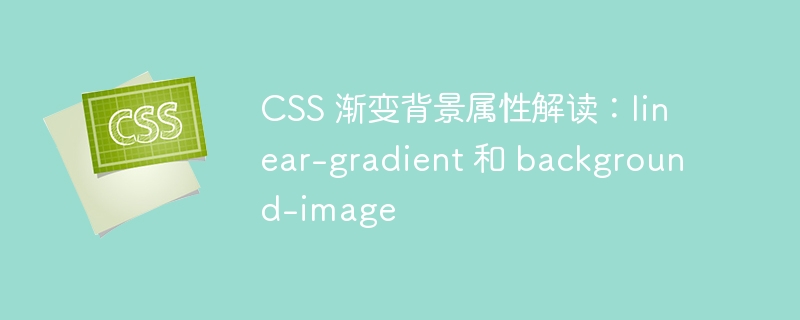 Web Front-end
Web Front-end
 CSS Tutorial
CSS Tutorial
 Interpretation of CSS gradient background properties: linear-gradient and background-image
Interpretation of CSS gradient background properties: linear-gradient and background-image
Interpretation of CSS gradient background properties: linear-gradient and background-image

Interpretation of CSS gradient background properties: linear-gradient and background-image
Introduction:
In page development, the selection of background color is a very important link , and gradient background colors can add richer visual effects to web pages. CSS provides two ways to implement gradient background properties: linear-gradient and background-image. This article will focus on explaining the use of these two methods and provide specific code examples.
1. Linear-gradient:
Linear-gradient is a function of CSS that can achieve a gradient effect from one color to another by specifying the starting color and ending color. Its basic syntax is as follows:
background-image: linear-gradient(direction, color-stop1, color-stop2, ...);
- ##direction: Specify the direction of the gradient, Can be one of the following values:
- to top: from bottom to top
- to bottom: from top to bottom
- to left: from right to left
- to right:from left to right
- to top left:from bottom right to top left
- to top right:from bottom left to top right
- to bottom left :From top right to bottom left
- to bottom right:From top left to bottom right
color-stop: Specify the color of the gradient, which can be a specific color value or Is a relative value (for example: 50% represents the color halfway in the current direction). There can be multiple color-stop values, separated by commas.
div {
background-image: linear-gradient(to top, #ff0000, #00ff00);
}In addition to using the linear-gradient gradient function, you can also Use the background-image property to achieve a gradient background effect. This method is more flexible and can add images or transitions to other elements in the gradient. The basic syntax is as follows:
background-image: url(image.png), linear-gradient(direction, color-stop1, color-stop2, ...);
- url(image .png): Specify the image path in the gradient background effect, which can be a relative path or an absolute path. If you don't need to add a picture, you can omit this section. Linear-gradient: Used in the same way as the linear-gradient function, used to specify the gradient effect.
div {
background-image: url(image.png), linear-gradient(to right, #ff0000, #00ff00);
}The above is the detailed content of Interpretation of CSS gradient background properties: linear-gradient and background-image. For more information, please follow other related articles on the PHP Chinese website!

Hot AI Tools

Undresser.AI Undress
AI-powered app for creating realistic nude photos

AI Clothes Remover
Online AI tool for removing clothes from photos.

Undress AI Tool
Undress images for free

Clothoff.io
AI clothes remover

Video Face Swap
Swap faces in any video effortlessly with our completely free AI face swap tool!

Hot Article

Hot Tools

Notepad++7.3.1
Easy-to-use and free code editor

SublimeText3 Chinese version
Chinese version, very easy to use

Zend Studio 13.0.1
Powerful PHP integrated development environment

Dreamweaver CS6
Visual web development tools

SublimeText3 Mac version
God-level code editing software (SublimeText3)

Hot Topics
 Vue 3
Apr 02, 2025 pm 06:32 PM
Vue 3
Apr 02, 2025 pm 06:32 PM
It's out! Congrats to the Vue team for getting it done, I know it was a massive effort and a long time coming. All new docs, as well.
 A bit on ci/cd
Apr 02, 2025 pm 06:21 PM
A bit on ci/cd
Apr 02, 2025 pm 06:21 PM
I'd say "website" fits better than "mobile app" but I like this framing from Max Lynch:
 Can you get valid CSS property values from the browser?
Apr 02, 2025 pm 06:17 PM
Can you get valid CSS property values from the browser?
Apr 02, 2025 pm 06:17 PM
I had someone write in with this very legit question. Lea just blogged about how you can get valid CSS properties themselves from the browser. That's like this.
 Using Markdown and Localization in the WordPress Block Editor
Apr 02, 2025 am 04:27 AM
Using Markdown and Localization in the WordPress Block Editor
Apr 02, 2025 am 04:27 AM
If we need to show documentation to the user directly in the WordPress editor, what is the best way to do it?
 Stacked Cards with Sticky Positioning and a Dash of Sass
Apr 03, 2025 am 10:30 AM
Stacked Cards with Sticky Positioning and a Dash of Sass
Apr 03, 2025 am 10:30 AM
The other day, I spotted this particularly lovely bit from Corey Ginnivan’s website where a collection of cards stack on top of one another as you scroll.
 Comparing Browsers for Responsive Design
Apr 02, 2025 pm 06:25 PM
Comparing Browsers for Responsive Design
Apr 02, 2025 pm 06:25 PM
There are a number of these desktop apps where the goal is showing your site at different dimensions all at the same time. So you can, for example, be writing
 How to Use CSS Grid for Sticky Headers and Footers
Apr 02, 2025 pm 06:29 PM
How to Use CSS Grid for Sticky Headers and Footers
Apr 02, 2025 pm 06:29 PM
CSS Grid is a collection of properties designed to make layout easier than it’s ever been. Like anything, there's a bit of a learning curve, but Grid is
 Google Fonts Variable Fonts
Apr 09, 2025 am 10:42 AM
Google Fonts Variable Fonts
Apr 09, 2025 am 10:42 AM
I see Google Fonts rolled out a new design (Tweet). Compared to the last big redesign, this feels much more iterative. I can barely tell the difference





